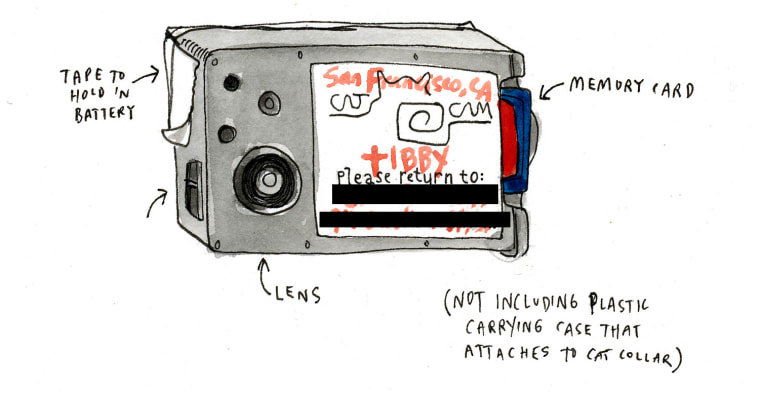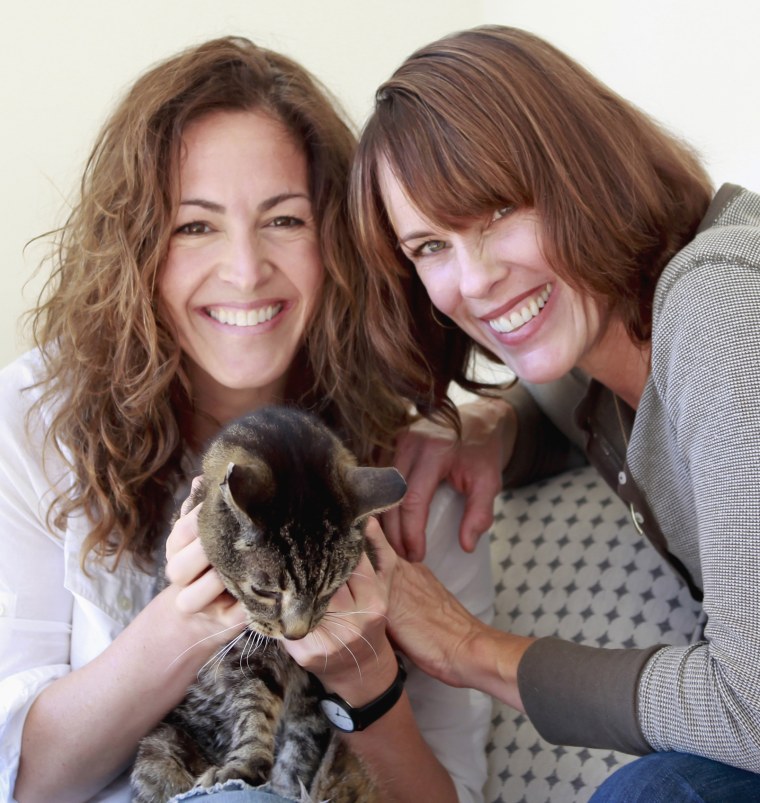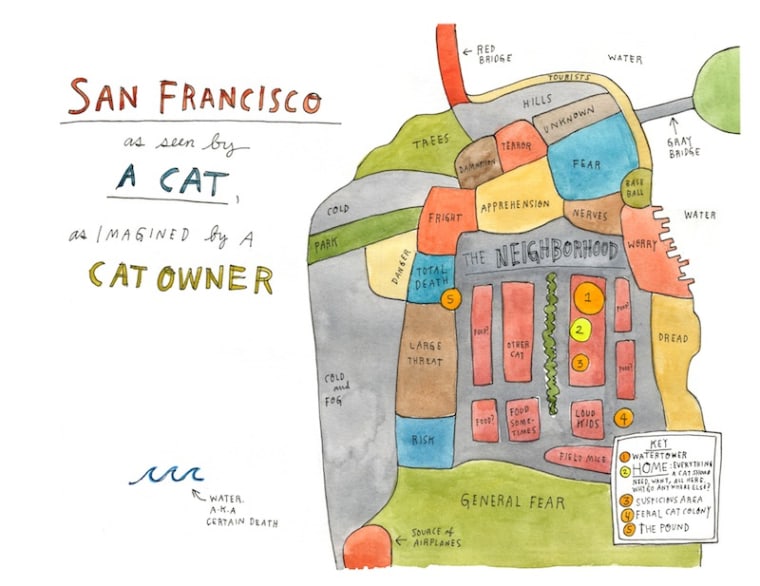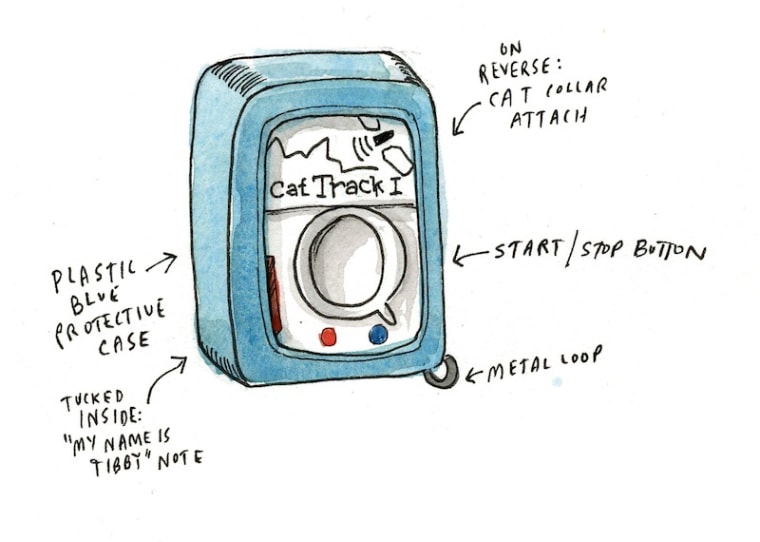When Tibia the house cat went missing from his comfortable San Francisco home in 2009, his doting owner Caroline Paul thought he was dead.
Five weeks later Tibby came back, fat and content.
"I think most people would be happy," Paul's partner Wendy MacNaughton, who was brought up with small dogs, told NBC News. But "that's when Caroline went a little crazy."
The mysteries of cats' second lives have haunted cat owners for years. But roaming habits of felines have tickled the fancy of animal behavior scientists as well. As technology becomes more sophisticated, both researchers and obsessive cat fanciers like Paul are learning about those secret cat excursions.
Tech is exactly what Paul turned to after Tibby came back, but still wasn't eating at home. He was being fed elsewhere, Paul was sure, but where, and by whom?
"I was dismayed," Paul told NBC News. "I thought I knew my cat — I thought he loved only me." She was stuck on the couch with stitches in her head, a bandaged arm, and a smooshed left ankle, recovering from crashing her experimental aircraft. She'd known MacNaughton a mere six months at that point. "The only thing I was sure of were my cats," Tibby and Fibula, she said. But Tibby? Tibby was seeing someone else.
And so, "like millions of betrayed women before her," MacNaughton says, Paul began to stalk her cat. She found a German maker of cat-sized GPS devices, bought one on the Internet, and strung it around Tibby's neck. He brought back 22 sets of data over a month, but mostly, MacNaughton says, "It was gobbledygook."

In Lost Cat: A True Story of Love, Desperation and GPS Technology, MacNaughton (illustrations) and Paul (words) describe their attempts to investigate Tibby the cat's second life, listing encounters with pet detectives, various tracking devices, even attempts at straight questions in an animal communications class. In the end, MacNaughton and Paul found answers (you'll have to read the book to know those). But they also found each other.

Though not nearly as personal as the couple's adventure with Tibby, the discoveries made by scientists who study cats can be just as illuminating.
Jeff Horn, now a land steward specialist at the Jo Daviess Conservation Foundation in Illinois, surveyed the roaming habits of 52 wild cats and house cats in the suburban farmland near Champaign-Urbana, stringing radio transmitters on the necks and tracking their roaming patterns within a 10-square-mile area for about a year and a half.
Horn and his team found that both kinds of cats wandered, but the wild cats wandered much further. "The owners, they were very surprised ... they didn't realize [their cats] were going as far as they were at times," even though the "home ranges" in that study compared to similar cat wandering studies done before, horn says.
In 2011, Kerrie Loyd, then a grad student at the University of Georgia, got urban cat owners near Atlanta to attach small cameras to the collars to their cats when they went out. Over about 11 months, she collected hours and hours of footage of their cats' secret alone time.
When the cameras came back, the cat, so to speak, was out of the bag.
Some owners were a little spooked to find that reptiles (like lizards) were a favorite snack among their cats. Because they were eating them on their outings and not bringing them home, the owners never found out, Kerrie Loyd, now a lecturer at Arizona State University told NBC News in an email. And more icky discoveries: "Twenty percent of our kitties went exploring down in the storm drain system regularly (yuck!)."
Curiously, the Kitty Cams caught "several" cats that were inexplicably seeking out other families for affection and food.

As to why cats wandered, both Loyd and Horn were stumped. But Roland Kays, a zoologist at North Caroline State University, has a guess.
"That's their million-year wild heritage that's in their DNA expressing itself," Kays told NBC News. Kays, whose feline tracking resume extends from house cats to ocelots to African lions, says that in the wild, cats' behavior and movement is shaped by three things: finding food, finding a mate, and crucially, not being eaten by something else.
But neutered, well-fed house cats want for none of those things. "It's puzzling what their motivation would be in that situation, if they didn't want to find a food or mate," he told NBC News.
Curious cat owners can check out Paul and MacNaughton's handy list of cat-tracking devices on their website, which ranges from cameras and GPS devices to drones. If they wanted to share that data, Kays, for one, would be thrilled. "This cat movement data could be very valuable to compare with other wild animals as well," he said.
If you chose to take on this adventure with your cat, Tibby's owner Paul advises that it's best to do it with an open heart.
"You have to accept that you can't know everything about the creature that you love, be it your girlfriend or your cat," Paul says. "And you just trust that love is enough ... When you give your heart to someone, when you love someone, lost is always implicit. And you just hope they come back. And Tibby came back."
For a full list of cat tracking devices, visit Paul and MacNaughton's How to track your cat page.
Cat owners are invited to share their tracking data with Roland Kays on movebank.org, a crowdsourced data base of wild animal roaming patterns.
Nidhi Subbaraman is a cat person. Follow her on Twitter and Google+.
